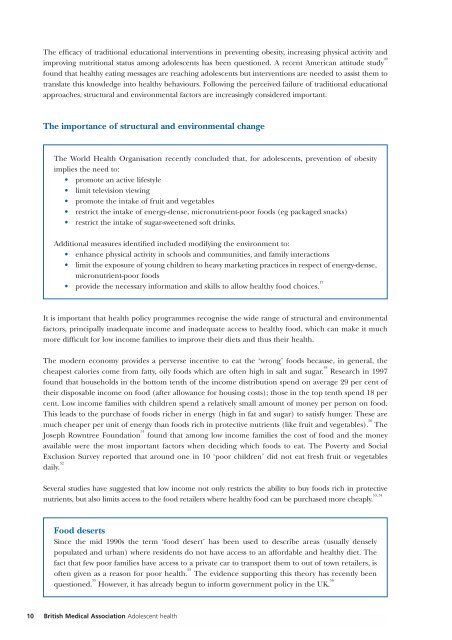Alcohol misuse: tackling the UK epidemic - London
Alcohol misuse: tackling the UK epidemic - London
Alcohol misuse: tackling the UK epidemic - London
You also want an ePaper? Increase the reach of your titles
YUMPU automatically turns print PDFs into web optimized ePapers that Google loves.
10<br />
The efficacy of traditional educational interventions in preventing obesity, increasing physical activity and<br />
improving nutritional status among adolescents has been questioned. A recent American attitude study 49<br />
found that healthy eating messages are reaching adolescents but interventions are needed to assist <strong>the</strong>m to<br />
translate this knowledge into healthy behaviours. Following <strong>the</strong> perceived failure of traditional educational<br />
approaches, structural and environmental factors are increasingly considered important.<br />
The importance of structural and environmental change<br />
The World Health Organisation recently concluded that, for adolescents, prevention of obesity<br />
implies <strong>the</strong> need to:<br />
• promote an active lifestyle<br />
• limit television viewing<br />
• promote <strong>the</strong> intake of fruit and vegetables<br />
• restrict <strong>the</strong> intake of energy-dense, micronutrient-poor foods (eg packaged snacks)<br />
• restrict <strong>the</strong> intake of sugar-sweetened soft drinks.<br />
Additional measures identified included modifying <strong>the</strong> environment to:<br />
• enhance physical activity in schools and communities, and family interactions<br />
• limit <strong>the</strong> exposure of young children to heavy marketing practices in respect of energy-dense,<br />
micronutrient-poor foods<br />
• provide <strong>the</strong> necessary information and skills to allow healthy food choices. 17<br />
It is important that health policy programmes recognise <strong>the</strong> wide range of structural and environmental<br />
factors, principally inadequate income and inadequate access to healthy food, which can make it much<br />
more difficult for low income families to improve <strong>the</strong>ir diets and thus <strong>the</strong>ir health.<br />
The modern economy provides a perverse incentive to eat <strong>the</strong> ‘wrong’ foods because, in general, <strong>the</strong><br />
cheapest calories come from fatty, oily foods which are often high in salt and sugar. 44<br />
Research in 1997<br />
found that households in <strong>the</strong> bottom tenth of <strong>the</strong> income distribution spend on average 29 per cent of<br />
<strong>the</strong>ir disposable income on food (after allowance for housing costs); those in <strong>the</strong> top tenth spend 18 per<br />
cent. Low income families with children spend a relatively small amount of money per person on food.<br />
This leads to <strong>the</strong> purchase of foods richer in energy (high in fat and sugar) to satisfy hunger. These are<br />
much cheaper per unit of energy than foods rich in protective nutrients (like fruit and vegetables). 50<br />
The<br />
Joseph Rowntree Foundation 51<br />
found that among low income families <strong>the</strong> cost of food and <strong>the</strong> money<br />
available were <strong>the</strong> most important factors when deciding which foods to eat. The Poverty and Social<br />
Exclusion Survey reported that around one in 10 ‘poor children’ did not eat fresh fruit or vegetables<br />
daily. 52<br />
Several studies have suggested that low income not only restricts <strong>the</strong> ability to buy foods rich in protective<br />
53, 54<br />
nutrients, but also limits access to <strong>the</strong> food retailers where healthy food can be purchased more cheaply.<br />
Food deserts<br />
Since <strong>the</strong> mid 1990s <strong>the</strong> term ‘food desert’ has been used to describe areas (usually densely<br />
populated and urban) where residents do not have access to an affordable and healthy diet. The<br />
fact that few poor families have access to a private car to transport <strong>the</strong>m to out of town retailers, is<br />
often given as a reason for poor health. 55<br />
The evidence supporting this <strong>the</strong>ory has recently been<br />
questioned. 55<br />
However, it has already begun to inform government policy in <strong>the</strong> <strong>UK</strong>. 56<br />
British Medical Association Adolescent health
















